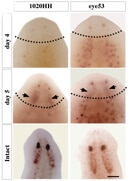2004
Journal Publication
Zoological Science
Morphological and Functional Recovery of the Planarian Photosensing System during Head Regeneration
Inoue T, Kumamoto H, Okamoto K, Umesono Y, Sakai M, Sánchez Alvarado A, Agata K
When exposed to light, planarians display a distinctive light avoidance behavior known as negative phototaxis. Such behavior is temporarily suppressed when animals are decapitated, and it is restored once the animals regenerate their heads. Head regeneration and the simple but reproducible phototactic response of planarians provides an opportunity to study the association between neuronal differentiation and the establishment of behavior in a simple, experimentally tractable metazoan. We have devised a phototaxis assay system to analyze light response recovery during head regeneration and determined that light evasion is markedly re-established 5 days after amputation. Immunohistological and in situ hybridization studies indicate that the photoreceptors and optic nerve connections to the brain begin by the fourth day of cephalic regeneration. To experimentally manipulate the light response recovery, we performed gene knockdown analysis using RNA interference (RNAi) on two genes (1020HH and eye53) previously reported to be expressed at 5 days after amputation and in the dorso-medial region of the brain (where the optic nerves project). Although RNAi failed to produce morphological defects in either the brain or the visual neurons, the recovery of the phototactic response normally observed in 5-day regenerates was significantly suppressed. The data suggest that 1020HH and eye53 may be involved in the functional recovery and maintenance of the visual system, and that the phototaxis assay presented here can be used to reliably quantify the negative phototactic behavior of planarians.
Address reprint requests to: Alejandro Sánchez Alvarado



